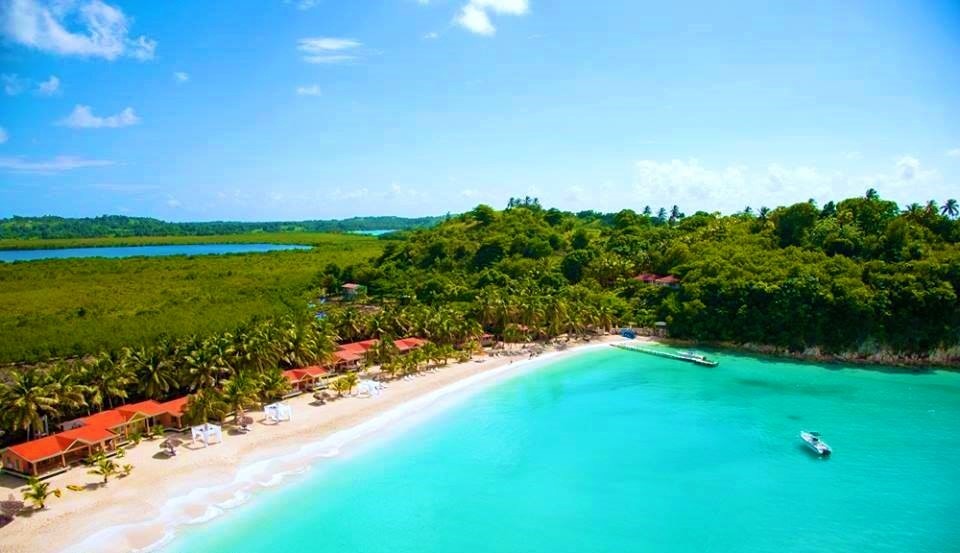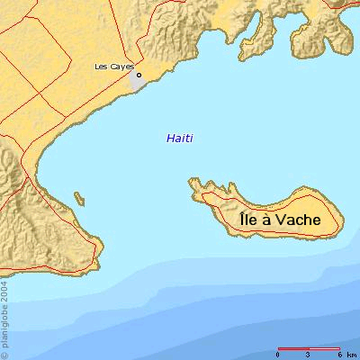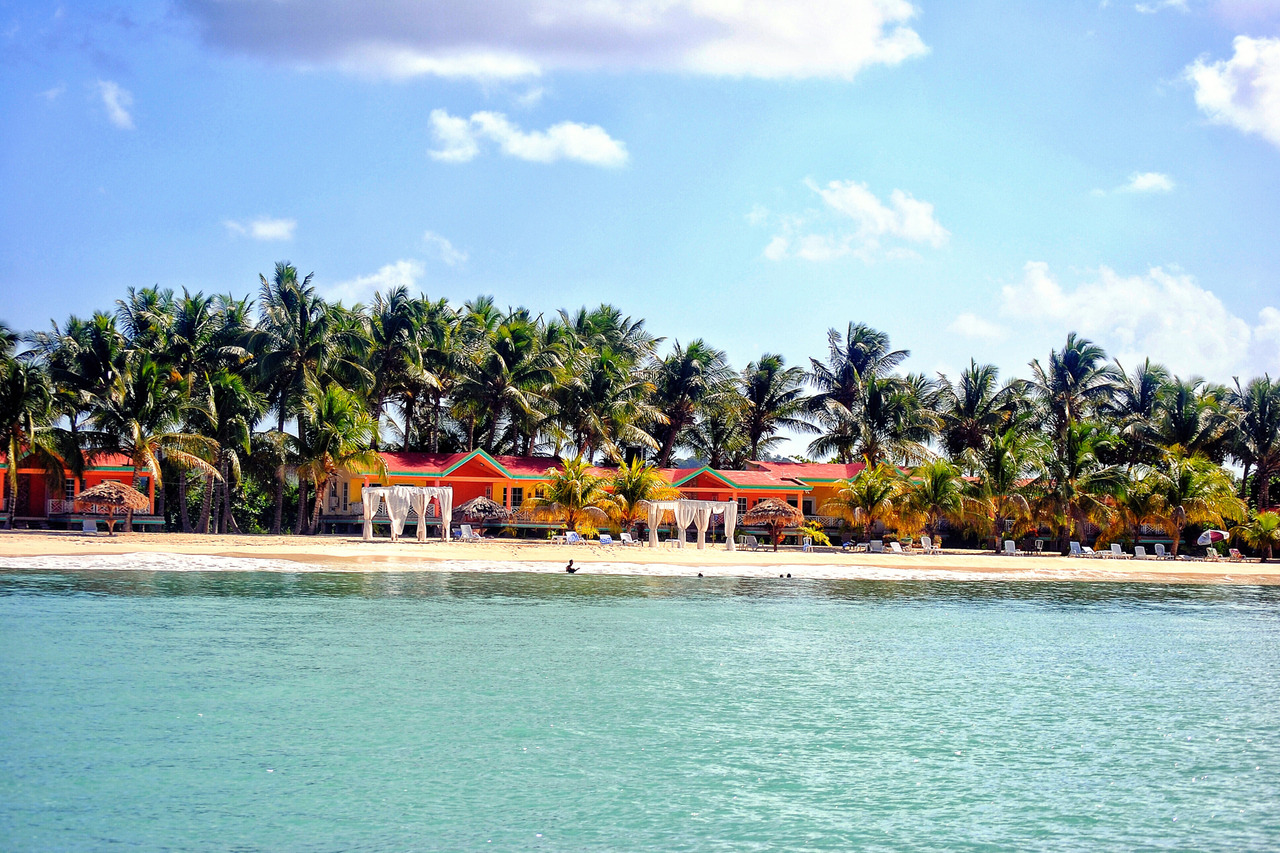🌴 Île à Vache 🐟
🇭🇹 Haiti 🇭🇹
🐄 🐃 🐄 🐂 🐄
Île-à-Vache, Haiti's Hidden Paradise
This is Île-à-Vache (Spanish: Isla Vaca; English: Cow Island) one of Haiti's hidden jewels. It lies in the Baie de Cayes about 6.5 miles off the coast of the country's southwest peninsula, roughly between the City of Les Cayes and Pointe l'Abacou. With its sugar-white beaches, verdant mountains and valleys brimming with tropical vegetation, this beautiful island is considered one of the most peaceful and romantic get-aways in the Caribbean.
With a population of approximately 20,000 people and an untouched ecosystem, Ile-à-Vâche remains one of the rare havens that (so far) does not accommodate cars or other four-wheel motorized vehicles. At a mere 30 minutes ferry ride from the port of Les Cayes, its character hasn’t changed over the years.
The island's modern history goes back to the discovery of Hispaniola in 1492, when it was first known to be Spanish territory, until it was turned to the French after the Ryswick Treaty of 1687 that ended a war between France and Spain. Over the two centuries, it was a place for both Spanish settlers and later the French buccaneers to safely raise their cattles, thus its name Isla Vaca (Spanish) or Ile-à-Vâche in French.
In 1697, the island of Hispaniola was formally divided between Spain and France in the Treaty of Ryswick which ended the Nine Years War. France assumed control of the western half of Hispaniola and named it Saint-Domingue, which later became "The Republic Haiti", the world's first black nation to gain its independence by successfully revolting against French colonization and slavery in 1804.
Music credit:
"Ayiti" by Michel Martely
With a population of approximately 20,000 people and an untouched ecosystem, Ile-à-Vâche remains one of the rare havens that (so far) does not accommodate cars or other four-wheel motorized vehicles. At a mere 30 minutes ferry ride from the port of Les Cayes, its character hasn’t changed over the years.
The island's modern history goes back to the discovery of Hispaniola in 1492, when it was first known to be Spanish territory, until it was turned to the French after the Ryswick Treaty of 1687 that ended a war between France and Spain. Over the two centuries, it was a place for both Spanish settlers and later the French buccaneers to safely raise their cattles, thus its name Isla Vaca (Spanish) or Ile-à-Vâche in French.
In 1697, the island of Hispaniola was formally divided between Spain and France in the Treaty of Ryswick which ended the Nine Years War. France assumed control of the western half of Hispaniola and named it Saint-Domingue, which later became "The Republic Haiti", the world's first black nation to gain its independence by successfully revolting against French colonization and slavery in 1804.
Music credit:
"Ayiti" by Michel Martely
🐄 🐃 🐄 🐂 🐄
💓 🇭🇹 🤎 🇭🇹 💓 🇭🇹 🤎 🇭🇹 💓 🇭🇹 🤎 🇭🇹 💓 🇭🇹 🤎 🇭🇹 💓
Île à Vache is a small Caribbean island lying off the south-west peninsula of Haiti near the town of Les Cayes. Administratively it is part of the Sud Department. It is about 8 miles long, 2 miles wide, with an area of 20 square miles

Île à Vache (French, also expressed Île-à-Vaches, former Spanish name Isla Vaca, both translated as Cow Island) is a small Caribbean island lying off the south-west peninsula of Haiti near the town of Les Cayes.
Administratively it is part of the Sud Department.

Île à Vache (French, also expressed Île-à-Vaches, former Spanish name Isla Vaca, both translated as Cow Island) is a small Caribbean island lying off the south-west peninsula of Haiti near the town of Les Cayes.
Administratively it is part of the Sud Department.
It is about 8 miles (13 km) long, 2 miles (3.2 km) wide, with an area of 20 square miles (52 km2).
The western end of the island is up to 150 metres (490 ft) high and rolling with several small swamps in the valleys; while the eastern section is swampy, and has a lagoon with one of the largest mangrove forests in Haiti.
The western end of the island is up to 150 metres (490 ft) high and rolling with several small swamps in the valleys; while the eastern section is swampy, and has a lagoon with one of the largest mangrove forests in Haiti.

It is one of the most popular tourist sites in Haiti and it has some of the best island scenery in the Caribbean. The population of the island is somewhere between 10,000-15,000 inhabitants.
There are two tourist resorts on the island, the Port Morgan and Abaka Bay.

Hotel Port Morgan
Île à Vache 🐬
DJI Phantom 3 drone footage

Île à Vache is a Caribbean island located in the Baie de Cayes, just south of Haiti. During the Golden Age of Piracy, it served as a French trading post.
Abaka Bay Resort
where time stands still…
Abaka Bay Resort voted “57th most beautiful beach in the world” CNN 2013 Top 100 Most beautiful beaches in the World.
https://www.abakabay.com
Abaka Bay Resort
Là où le temps s’arrête...
Abaka Bay est l’une des plus belles destinations au monde!
La plage de Abaka Bay Resort classée 57ème parmi les plus belles plages du monde selon (CNN Top 100 plus belles plages du monde.)
Découvrez les épaves aux trésors
L’île-a-vache est un petit joyau de terre charmant et discret situé a quelques brasses de la côte sud-ouest de l’île d’Haiti, en face de la ville des Cayes.
Constamment caressée par les doux alizés et les flots bleus de la mer des Antilles, cette île minuscule offre un environnement naturel des plus attrayants aux visiteurs désirant se détendre et se recréer a l’abri des tumultes de la grande ville. L’un des grands amiraux de cette période, en l’occurrence le capitaine Henry Morgan (1635-1688) entreprit plusieurs expéditions contre les possessions espagnoles dans les Antilles, l’île-a-Vache fut l’un des ses repaires privilégiés. L’histoire rapporte que de nombreux vaisseaux chargés de butins de toutes sortes auraient sombré dans les environs. Conséquemment plusieurs expéditions eurent lieu au cours des siecles a la recherche d’épaves et de leurs cargaisons.
Aujourd’hui, il n’est pas rare de surprendre quelques visiteurs allongés sur le sable fin avec une énorme coquille de conche (communément appelée Lambi) rivée a leurs oreilles et scrutant l’horizon, a la recherche de quelques échos de l’histoire.
https://www.abakabay.com/fr
where time stands still…
Abaka Bay Resort voted “57th most beautiful beach in the world” CNN 2013 Top 100 Most beautiful beaches in the World.
https://www.abakabay.com
Abaka Bay Resort
Là où le temps s’arrête...
Abaka Bay est l’une des plus belles destinations au monde!
La plage de Abaka Bay Resort classée 57ème parmi les plus belles plages du monde selon (CNN Top 100 plus belles plages du monde.)
Découvrez les épaves aux trésors
L’île-a-vache est un petit joyau de terre charmant et discret situé a quelques brasses de la côte sud-ouest de l’île d’Haiti, en face de la ville des Cayes.
Constamment caressée par les doux alizés et les flots bleus de la mer des Antilles, cette île minuscule offre un environnement naturel des plus attrayants aux visiteurs désirant se détendre et se recréer a l’abri des tumultes de la grande ville. L’un des grands amiraux de cette période, en l’occurrence le capitaine Henry Morgan (1635-1688) entreprit plusieurs expéditions contre les possessions espagnoles dans les Antilles, l’île-a-Vache fut l’un des ses repaires privilégiés. L’histoire rapporte que de nombreux vaisseaux chargés de butins de toutes sortes auraient sombré dans les environs. Conséquemment plusieurs expéditions eurent lieu au cours des siecles a la recherche d’épaves et de leurs cargaisons.
Aujourd’hui, il n’est pas rare de surprendre quelques visiteurs allongés sur le sable fin avec une énorme coquille de conche (communément appelée Lambi) rivée a leurs oreilles et scrutant l’horizon, a la recherche de quelques échos de l’histoire.
https://www.abakabay.com/fr
What to do at Île à Vache
🐬 🇭🇹 🐬 🇭🇹 🐬 🇭🇹 🐬 🇭🇹 🐬 🇭🇹 🐬 🇭🇹 🐬
No comments:
Post a Comment